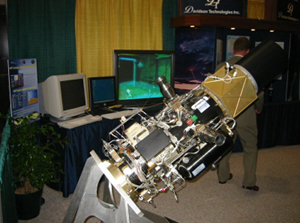
KE ASAT in the Davidson Technologies booth at a
recent SMDC conference in Huntsville, AB.
It turns out KE ASAT is alive and well, living in Alabama.
For those of you who don’t remember, the KE ASAT is a giant, kevlar fly swatter that is supposed to whack satellites out of the orbit. The problem is that, even with some mitigation measures, it would generate too much debris for the boys at STRATCOM. The Pentagon hasn’t asked for KE ASAT money in the past few budgets.
Still, KE ASAT has friends in powerful places. In FY 2004 and FY 2005, Congress snuck money into the budget for KE ASAT: $7.5 M under MDA Ballistic Missile Defense Technology in FY 2004 and $14.0 M in 2005 under MDA Ballistic Missile Defense Products.
The program is now called Army Counter Space Technology
Testbed (or Applied Counterspace Technology). The Army—using its laundered MDA money—awarded Miltec Corporation of Huntsville, AB a $4 M increment of a $12.4 M contract in May 2004 for an Army counterspace technology testbed.
I didn’t notice the award until Theresa Hitchens forwarded me an Inside Defense story from December 2004. Keith Costa at Inside Defense reported that the KE ASAT money is now being used to develop termporary and reversible ASAT capabilities.
The Army, it turns out, has been keeping KE ASAT alive on stockpiled funds as the Space Control Test Capability, tossing some baksheesh to a company called Davidson Technologies every couple of years. Here are two past contract awards from 2001 and 2003.
SMDC has issued a statement of work for a third award that, among other things:
The contractor will support Counter Space Systems flight test as needed. Flight Test activities will include flight test analyses, test range activities to include site selection, safety analysis, and trajectory analysis.
A KE ASAT flight test? Strong work.

since we’ve got the upper hand, and majority of vehicles, in space, i think it’s a bad idea to ignore the implications of space junk created by this system.
orbitting debris often travels at speeds ranging in the 10s or 100s of tousands of miles per hour.
looks like a double duh-huh-doh situation to me.
we might as well make rifles that shoot an extra bullet out the back of the breach, in case someone is sneaking up behind you.
monte – mnl@uwm.edu
Has anyone done an estimated half-life of the debris from a low orbit whack? If it is rather short it may be worth the risk in a war situation against military targets.
I would expect, after such a violent wack in low orbit, most of the pieces would be out of orbit and on the ground in the time it took the target to make a few loops around the earth. (That’s just my laymans logic of course.)
Appendix E of the FAS report, by John L. Remo, attempted to model the debris creation from a missile defense intercept, but that is the most specific that I’ve seen.
The October 1985 ALMV test that destroyed the Solwind satellite generated several large pieces of debris that remained in orbit for more than a decade (evident from the orbital catalogues). One of the pieces reportedly of debris passed about 1.3 km from the ISS in 1999.